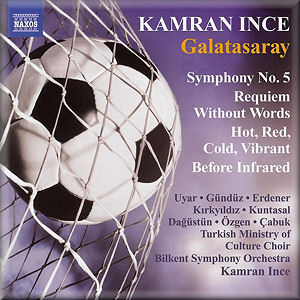 |
 |
|


alternatively
CD:
MDT
AmazonUK
AmazonUS
Sound Samples & Downloads
|
Kamran INCE (b.1960)
Hot, Red, Cold, Vibrant (1992) [9:33]
Symphony no.5 'Galatasaray' (2005) [33:14]
Requiem Without Words (2004) [20:09]
Before Infrared (1986) [12:30]
 Tülay Uyar (soprano: Symphony)
Tülay Uyar (soprano: Symphony)
Levent Gündüz (tenor: Symphony)
Anil Kirkyildiz (boy soprano: Symphony)
Selva Erdener (ethnic voice: Requiem)
Olça Kuntasal (soprano: Requiem)
Güvenç Dagüstün (baritone: Requiem)
Neva Özgen (kemenche: Requiem)
Ali Çabuk (tambur: Requiem)
Turkish Ministry of Culture Choir (Galatasaray)
Bilkent Symphony Orchestra/Kamran Ince
rec. Bilkent Concert Hall, Ankara, June 2006; December 2005 [Symphony],
June 2007 [Before Infrared]. DDD
 NAXOS 8.572553 [75:38]
NAXOS 8.572553 [75:38] 
|
|
|
It has been six years since Naxos released American composer
Kamran Ince's first CD. It featured his Third and Fourth Symphonies
and was warmly reviewed here.
Like buses, however, Naxos has, in addition to the present disc,
sent along three further volumes of Ince's music - 8.572554,
9.70011 and 9.70141 - though as yet these three are only available
as downloads.
This CD, like the previous one, has been issued in Naxos's "21st
Century Classics" series. At least this time two of the
works were actually written in the 21st century - the three
on the fist disc dated from between 1993 and 2000. Nevertheless,
the earliest piece on this new release was composed in 1986,
and a second in 1992; moreover, if any works in this programme
are classics, Naxos could have made it clearer which.
With Hot, Red, Cold, Vibrant, Ince's aim, according to
the unusually hagiographical liner-notes, was "to capture
the driving energy of rock on his own terms". What exactly
that means is open to debate, but there is no doubt that this
is a rumbling, hissing, honking steamroller of a work that,
well, trundles on until finally running out of fuel. With its
similar use of blazing brass over deep, throbbing strings and
ominous bursts on the bass drum, Before Infrared sounds
like a less noisy companion piece to Hot, Red, Cold, Vibrant,
but in fact it was written to complement another orchestral
work, Infrared Only, recorded on Naxos 8.572554. Neither
of these pieces is earth-shattering – sub-John Adams is a reasonable
description - but there is a certain amount of pleasure to be
had for a while from their brash flash.
On the other hand, the Requiem Without Words and the
'Galatasaray' Symphony are, it is probably fair to say,
both love-'em-or-hate-'em works. The elements that some - or
perhaps many - listeners may find variously annoying, ridiculous
or appalling are similar in both works. Firstly, there is the
'extra voice' aspect - in the Requiem, the "ethnic"
voice is strident to the point of overwhelming. In the Symphony
- which is actually more cantata than symphony - the boy soprano's
voice in its lower registers is inconsistently intoned and insipid.
Secondly, in the opening section of the Requiem a clicking
noise accompanies the voices; whereas in the Symphony there
is an incessant, unvarying and intrusive bass drone behind virtually
all but the first minute of the first movement. And in fact,
like Ince's beloved thumping bass, it hardly ever goes away,
until the work reaches its 'climax' in the opening of the musical
theatre-like finale.
The Requiem is a worthy work, in that it was written
to mourn the dozens of civilians killed in Istanbul in 2003
by religious maniacs using lorry bombs. It has a number of good
moments, steeped in poignancy, but in the final reckoning tends
towards the clangourous, rambling and repetitious.
The Symphony was written for an altogether different reason,
rather less noble: to celebrate the centenary of a Turkish football
club - the 'Galatasaray' of the title. Even more so than
the Requiem, it makes a lot of noise that does not conceal
the fact that it is repetitive, glutinous and ultimately quite
bland. The long 'cantata' text is tribal and posturing - as
ludicrously overblown as the status of football in contemporary
society. Ince's idea to set it to music without a hint of irony
is artistically dubious - though likely very sound from a commercial
point of view!
Generally speaking, the performances on this CD range from reasonable
to good. Naxos have omitted to provide any information at all
about the soloists. Recording quality is high throughout, but
most of the voices are over-miked. The booklet contains the
lyrics of the texts sung during 'Galatasaray', although
only in English translation - no Turkish original to follow,
which is especially tough on any Turks taking an interest in
a half-Turkish composer - or their favourite football team.
The booklet notes, by Tom Strini, tend, as already mentioned,
towards the fawning. They also contain several moments of pretentiousness,
such as this cringe-making summing up of the Requiem,
complete with unlikely accusative case in the Latin: "Even
in a hateful, violent world, final peace is not only possible
but inevitable - for all of us. Requiescat in pacem."
There is plenty of rhythm in these works - more often than not
expressed in part by loud bass drums - and there is plenty of
noise, but there is rather less in the way of substance and
almost no subtlety or variety; Stravinsky and Orff would surely
roll their eyes and shake their heads. On the other hand, those
who are happy to be bludgeoned by their music, or who equate
volume with passion, should find much to enjoy in Ince's music.
Byzantion
Collected reviews and contact at reviews.gramma.co.uk
|
|

